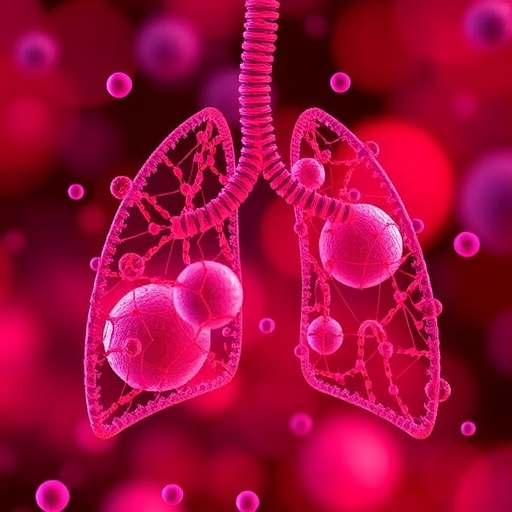Scientists Uncover Size and Polymer-Dependent Toxicity of Micro- and Nanoplastics in Human Lung Cells
The escalating concern over microscopic plastic pollution in the environment has taken a significant leap forward with groundbreaking research elucidating the toxic impacts of micro- and nanoplastics on human respiratory cells. In a recent study published in Microplastics and Nanoplastics, an international team of researchers delved deeply into how variations in size and polymer type of amorphous micro- and nanoplastics influence their toxicity on human bronchial epithelial cells. This revelation not only advances our comprehension of airborne plastic pollution but also raises critical red flags regarding potential health risks associated with inhalation exposure to such particles.
The ubiquity of microplastics, particles smaller than 5 millimeters, and nanoplastics, often defined as plastics less than 100 nanometers in size, has been established across myriad ecosystems—from oceans and soil to urban air. However, scientific understanding of their biological interactions, particularly in human tissues, remains embryonic. The latest findings build upon this knowledge gap by systematically assessing the cellular responses to environmentally relevant plastic particles, emphasizing how their size and polymer composition modulate toxicity mechanisms within bronchial epithelial cells, which line the respiratory tract and serve as a critical barrier against inhaled pollutants and pathogens.
.adsslot_1grMtsRy4Q{ width:728px !important; height:90px !important; }
@media (max-width:1199px) { .adsslot_1grMtsRy4Q{ width:468px !important; height:60px !important; } }
@media (max-width:767px) { .adsslot_1grMtsRy4Q{ width:320px !important; height:50px !important; } }
ADVERTISEMENT
Polymer composition, an often overlooked variable in microplastic toxicity studies, proved equally influential. The team found that certain polymers elicited more pronounced cytotoxic and inflammatory responses than others. For instance, particles composed of polystyrene—ubiquitous in packaging and consumer products—showed heightened toxicity metrics relative to polyethylene or polypropylene. Such findings compel a reevaluation of environmental risk assessments that traditionally treat microplastics as a homogeneous class, ignoring the nuanced role polymer chemistry plays in biological interactions.
Intriguingly, the study’s meticulous attention to environmentally relevant conditions enhances the real-world applicability of its conclusions. Many previous toxicological investigations relied on artificially engineered particles or unrealistically high exposure doses, limiting their ecological and health relevance. By focusing on plastic particles isolated from environmental samples—bearing authentic shapes, surface chemistries, and sizes—the researchers underscored the actual threat posed by ambient micro- and nanoplastics, especially in urban atmospheres where plastic contamination is high.
Respiratory exposure to particulate matter is historically linked to adverse health outcomes, but adding micro- and nanoplastics to this equation introduces a newly recognized category of inhalable contaminants. Given their persistence in the environment and propensity for bioaccumulation, continual inhalation of these particles could have cumulative and perhaps synergistic detrimental effects. This novel body of work decisively advocates for including micro- and nanoplastics in air quality monitoring schemes and risk regulations, refining public health strategies to encompass these emerging pollutants.
Mechanistically, the research highlights the role of particle-induced oxidative stress as a core driver of cellular damage and inflammation. Reactive oxygen species not only cause direct harm to DNA, proteins, and lipids but also serve as signaling molecules that modulate gene expression related to inflammatory pathways. The study’s demonstration that smaller nanoplastics induce disproportionately higher ROS generation is particularly alarming, given that oxidative stress is implicated in a wide array of chronic diseases, including carcinogenesis. These insights open avenues for further investigation into interventions that could mitigate oxidative damage resulting from plastic particle exposure.
As regulatory bodies endeavor to address the burgeoning microplastic crisis, this meticulous assessment of size- and polymer-dependent toxicity offers essential scientific validation for more granular guidelines. Not all plastics are created equal in terms of human health risk—recognizing this heterogeneity will encourage policies tailored to prioritize control of the most hazardous plastic types. Moreover, by drawing attention to nanoplastics, often overlooked due to detection challenges, the research spotlights an urgent need for improved analytical technologies capable of tracking these elusive pollutants.
The research team’s experimental approach also incorporated advanced microscopy and molecular assays, enabling visualization and quantification of particle internalization and cellular injury. Such methodological rigor enhances confidence in the results and serves as a blueprint for other researchers aiming to decipher the intricate interactions between emerging contaminants and human biology. The visual evidence of plastic particles embedded within cell cytoplasm underscores the penetrating potential of nanoplastics, further substantiating toxicity concerns.
In conclusion, the study by Gosselink and colleagues represents a pivotal advance in environmental toxicology, revealing that the toxicity of micro- and nanoplastics is intricately dependent on both particle size and polymer composition, with significant implications for human respiratory health. As microplastic pollution proliferates globally, understanding these nuanced toxicological profiles is indispensable for developing evidence-based risk assessments, regulatory policies, and mitigation strategies designed to protect human populations from the insidious effects of microscopic plastic particles lurking invisibly in our air.
Subject of Research: Toxicological effects of size- and polymer-dependent amorphous micro- and nanoplastics on human bronchial epithelial cells
Article Title: Size- and polymer-dependent toxicity of amorphous environmentally relevant micro- and nanoplastics in human bronchial epithelial cells
Article References:
Gosselink, I.F., Leonhardt, P., Höppener, E.M. et al. Size- and polymer-dependent toxicity of amorphous environmentally relevant micro- and nanoplastics in human bronchial epithelial cells. Micropl.&Nanopl. 5, 19 (2025). https://doi.org/10.1186/s43591-025-00126-9
Image Credits: AI Generated
Tags: biological interactions of nanoplasticsbronchial epithelial cell exposureenvironmental impact of microplasticshuman health and microplasticsinhalation exposure to microplasticsmicroplastics lung toxicitynanoplastics health risksplastic pollution respiratory effectspolymer type influence on toxicityrespiratory health and plastic pollutionsize-dependent toxicity of plasticstoxic effects of airborne plastics





